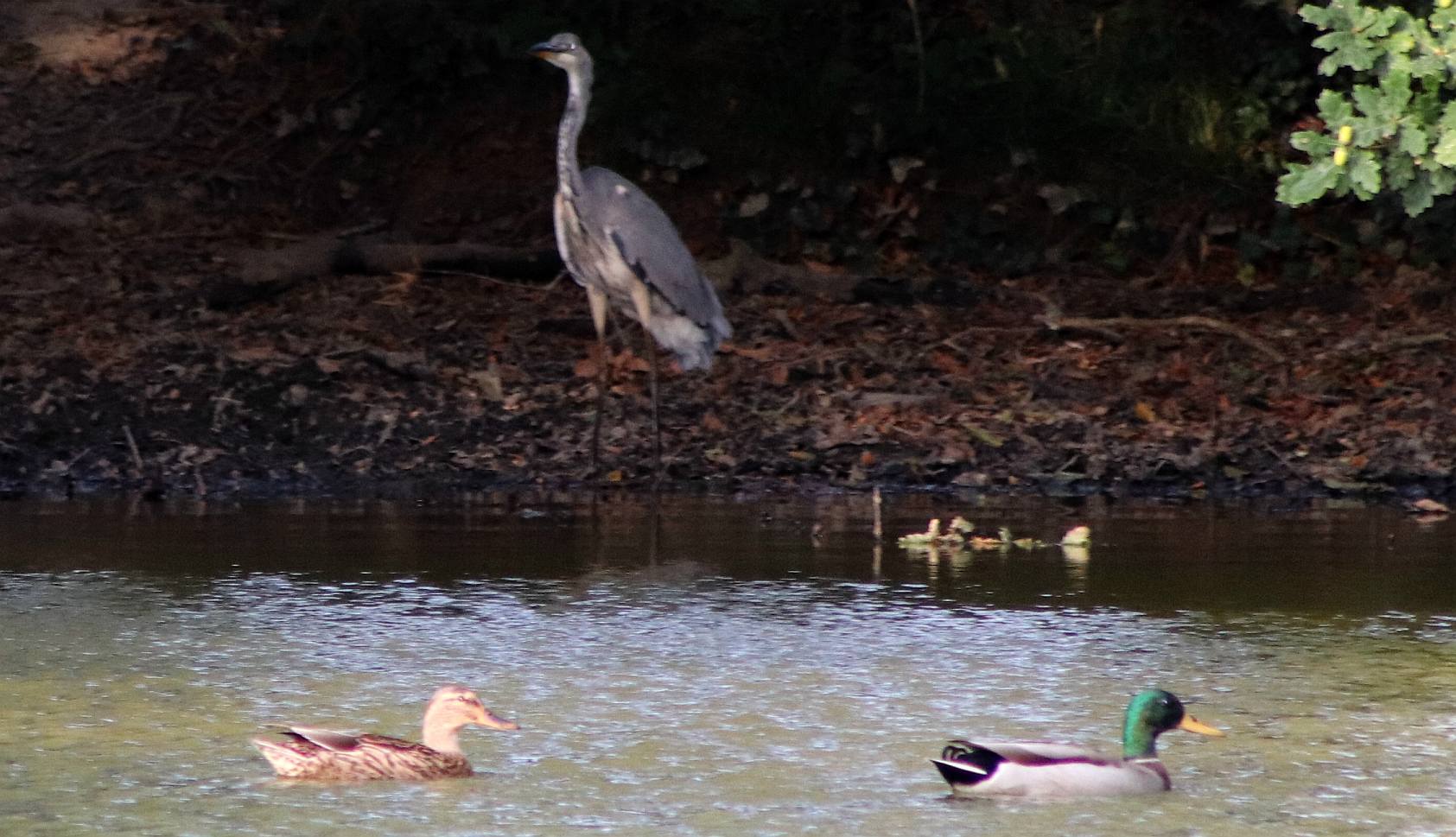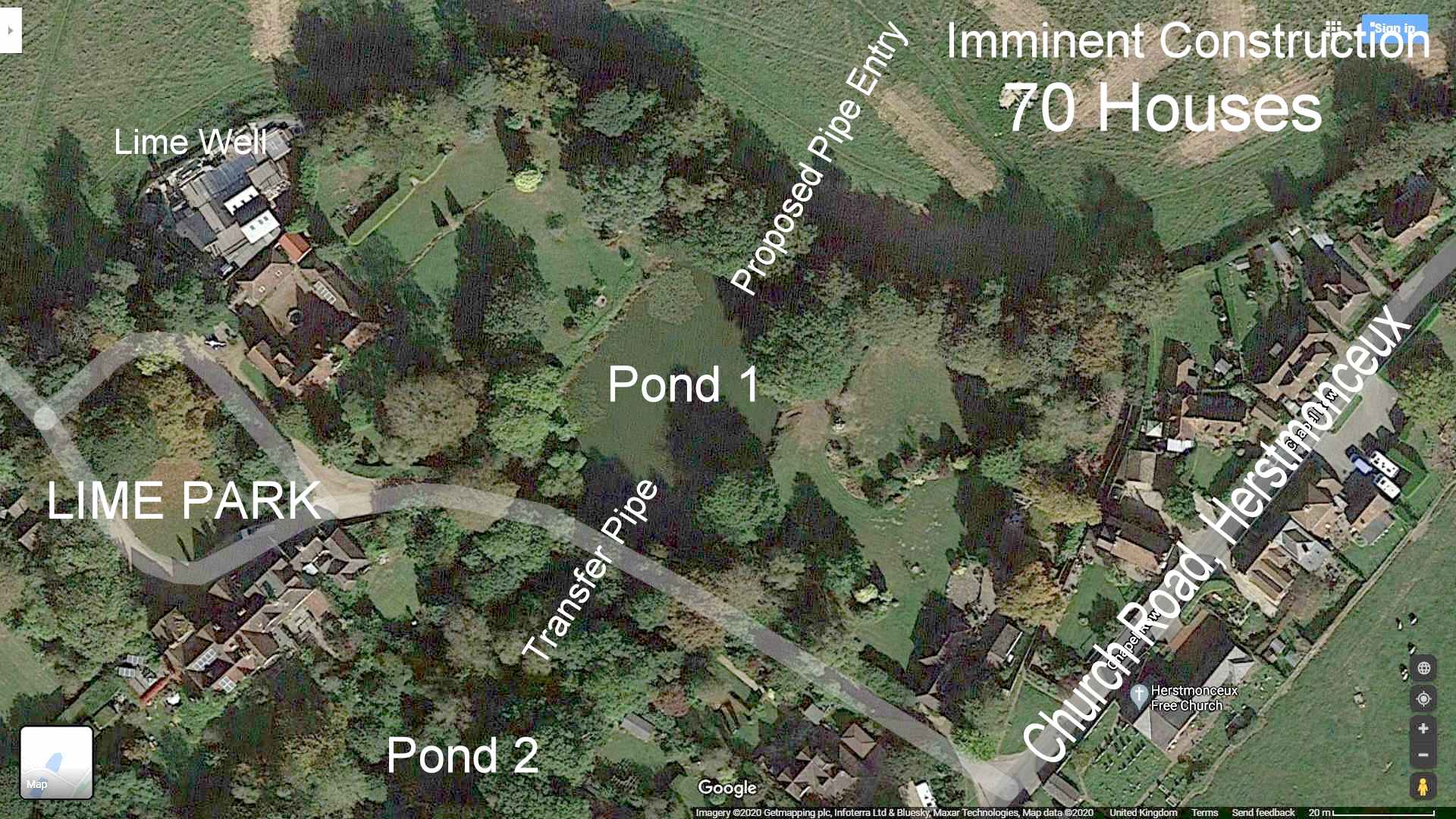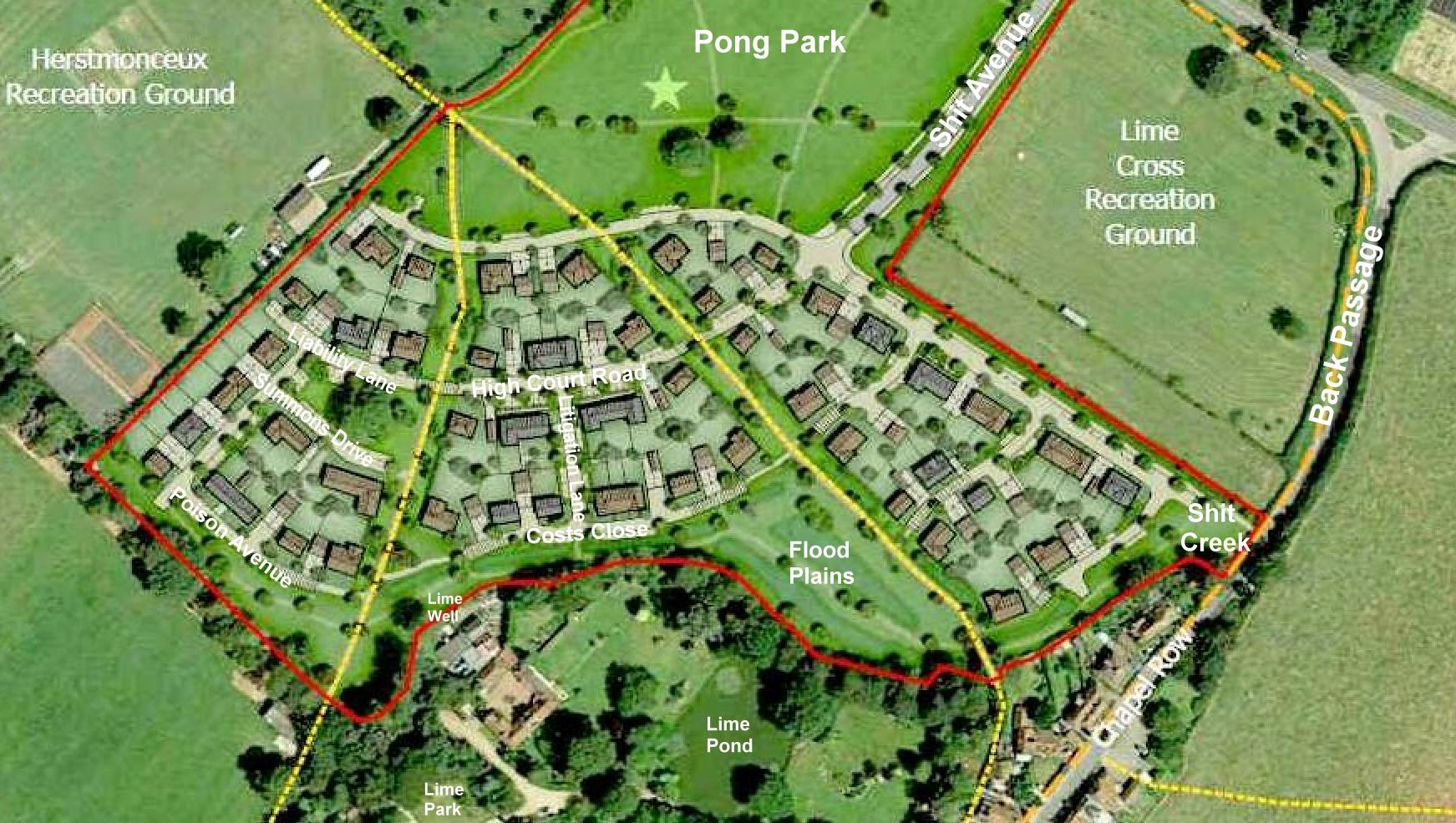
IMMINENT
THREAT OF POISONING -
A Heron seen here with Mallard Ducks on the pond in Lime Park on the
27th of September 2020. It is proposed by Latimer
Developments Limited, to pass surface water drainage through this
pond, despite the detrimental effect that bio accumulative poisoning is
sure to have from pesticides used on the gardens of the 70 houses they
intend building.
In
1997 suspected planning crime was reported to Sussex
police, following a petition to Wealden District Council. There were
12 separate complaints from unrelated complainants, but this police
force failed to investigate any of the reported crimes. Now some 23
years later, suspect planning consents are still flowing. It is alleged
that this is one case where the planning officers have turned a blind
eye to their duty to protect these birds - and of course the fish and
flora of Lime Park. One thing is for sure, Sussex
police are unlikely to investigate any matter concerning any Wealden
planning officer, let alone tangle with the likes of the developers, or
any person doing a deal with the developers. Even if fraud or conspiracy
to pervert the course of justice, or indeed to kill these birds is
involved. Killing a bird by poisoning is an imprisonable offence.
WHAT
IS A HABITATS REGULATION ASSESSMENT ?
A Habitats Regulations Assessment (HRA) refers to the several distinct stages of Assessment which must be undertaken in accordance with the Conservation of Habitats and Species Regulations 2017 (as amended) and the Conservation of Offshore Marine Habitats and Species Regulations 2017 (as amended) to determine if a plan or project may affect the protected features of a habitats site before deciding whether to undertake, permit or authorise it. European Sites and European Offshore Marine Sites identified under these regulations are referred to as ‘habitats sites’ in the National Planning Policy Framework.
All plans and projects (including planning applications) which are not directly connected with, or necessary for, the conservation management of a habitat site, require consideration of whether the plan or project is likely to have significant effects on that site. This consideration – typically referred to as the ‘Habitats Regulations Assessment screening’ – should take into account the potential effects both of the plan/project itself and in combination with other plans or projects. Where the potential for likely significant effects cannot be excluded, a competent authority must make an appropriate assessment of the implications of the plan or project for that site, in view the site’s conservation objectives. The competent authority may agree to the plan or project only after having ruled out adverse effects on the integrity of the habitats site. Where an adverse effect on the site’s integrity cannot be ruled out, and where there are no alternative solutions, the plan or project can only proceed if there are imperative reasons of over-riding public interest and if the necessary compensatory measures can be secured.
Paragraph: 001 Reference ID: 65-001-20190722 Revision date: 22 07 2019

COMPETENT
AUTHORITY -
During our enquiries, it was difficult to determine if Natural England
or the Royal Society for the Protection of Birds were competent or
considered themselves a local authority. It seemed a bit like a game of
pass the buck in a United Kingdom with a failed economy. By which we
mean that any economy that is substantially in the red without any
reasonable prospect of returning to the black, must be seen as having failed.
An economy with positive reserves is an economy that is thriving. And
this is one reason that the UK has failed on climate change and will
have great difficulty changing its ways. Because, politicians have
relied for so long on borrowing, when they had no chance of paying back
- just to win elections.
THE
REGULATIONS
Competent
authorities
7.—(1) For the purposes of these Regulations, “competent authority” includes—
(a) any Minister of the Crown (as defined in the Ministers of the Crown Act 1975(1)), government department, statutory undertaker, public body of any description or person holding a public office;
(b) the Welsh Ministers; and
(c) any person exercising any function of a person mentioned in sub-paragraph (a) or (b).
(2) In the following provisions (and as provided in regulation 69(3)(a)), “competent authority” includes the Scottish Ministers—
(a) regulation 70(2), in so far as that paragraph relates to a deemed grant of planning permission under—
(i) section 57(2), (2A) and (2ZA) of the Town and Country Planning (Scotland) Act 1997(2), to which regulation 70(1)(e)(ii) and (f) relate; or
(ii) section 5(1) of the Pipe-lines Act 1962(3), to which regulation 70(1)(e)(iii) relates;
(b) Chapters 4 and 5 of Part 6.
(3) In paragraph (1)—
“public body” includes—
(a) the Broads Authority(4);
(b) a joint planning board within the meaning of section 2 of the TCPA 1990 (joint planning boards)(5);
(c) a joint committee appointed under section 102(1)(b) of the Local Government Act 1972 (appointment of committees)(6);
(d) a National Park authority; or
(e) a local authority, which in this regulation means—
(i) in relation to England, a county council, a district council, a parish council, a London borough council, the Common Council of the City of London, the sub-treasurer of the Inner Temple or the under treasurer of the Middle Temple;
(ii) in relation to Wales, a county council, a county borough council or a community council;
“public office” means—
(a) an office under the Crown,
(b) an office created or continued in existence by a public general Act or by legislation passed by the National Assembly for Wales, or
(c) an office the remuneration in respect of which is paid out of money provided by Parliament or the National Assembly for Wales.
Duties in relation to wild bird habitat
10.—(1) Without prejudice to regulation 9(1), the appropriate authority, the nature conservation bodies and, in relation to the marine area, a competent authority must take such steps in the exercise of their functions as they consider appropriate to secure the objective in paragraph (3), so far as lies within their powers.
(2) Except in relation to the marine area, the Environment Agency, the Forestry Commissioners(1), local authorities, the Broads Authority and National Park authorities must take such steps in the exercise of their functions as they consider appropriate to contribute to the achievement of the objective in paragraph (3).
(3) The objective is the preservation, maintenance and re-establishment of a sufficient diversity and area of habitat for wild birds in the United Kingdom, including by means of the upkeep, management and creation of such habitat, as appropriate, having regard to the requirements of Article 2 of the new Wild Birds Directive (measures to maintain the population of bird species).
(4) Paragraph (1) applies, in particular, to—
(a) functions under these Regulations;
(b) functions under the following enactments—
(i) sections 17, 18, 20 and 21(6) of the 1949 Act (nature reserves)(2);
(ii) section 7 of the Natural Environment and Rural Communities Act 2006 (management agreements);
(iii) Parts 3, 4, 5 and 6 of the Marine Act (marine planning, marine licensing, nature conservation and management of inshore fisheries, respectively);
(c) any function exercisable in relation to town and country planning.
(5) Paragraph (2) applies, in particular, to—
(a) functions under these Regulations;
(b) functions under the following enactments—
(i) sections 21 and 90 of the 1949 Act (nature reserves and local authority byelaws, respectively)(3);
(ii) sections 3 and 10 of the Forestry Act 1967 (management of forestry land, and applications for felling licence and decision of Commissioners thereon, respectively) (4);
(iii) sections 3 and 6 of the Norfolk and Suffolk Broads Act 1988 (the Broads Plan and byelaws, respectively)(5);
(iv) section 66 of the Environment Act 1995 (National Park Management Plans)(6);
(v) sections 38 and 39 of the Flood and Water Management Act 2010 (which relate to incidental flooding or coastal erosion)(7);
(c) any function exercisable in relation to town and country planning.
(6) In section 123(3)(a) of the Marine Act (creation of network of conservation sites), as it applies in relation to the marine area(8), the reference to “the conservation or improvement of the marine environment” includes the objective in paragraph (3), and accordingly the duty in section 124 of the Marine Act (report) applies in relation to that objective.
(7) In considering which measures may be appropriate for the purpose of securing or contributing to the objective in paragraph (3), appropriate account must be taken of economic and recreational requirements.
(8) So far as lies within its powers, a competent authority in exercising any function in or in relation to the United Kingdom must use all reasonable endeavours to avoid any pollution or deterioration of habitats of wild birds (except habitats beyond the outer limits of the area to which the new Wild Birds Directive applies).
(9) The appropriate authority must take any steps it considers necessary to facilitate or co-ordinate arrangements to secure the taking of steps under paragraphs (1) and (2) by the bodies mentioned in those paragraphs.
(10) After consultation with the appropriate nature conservation body, the appropriate authority must give guidance to the Environment Agency, the Forestry Commissioners, the Natural Resources Body for Wales, local authorities, the Broads Authority, National Park authorities and any other competent authority it considers appropriate—
(a) to facilitate the determination by those bodies of the extent to which the diversity and area of habitat for wild birds is sufficient; and
(b) on the steps that it may be appropriate to take under paragraph (1) or (2).
(11) In exercising a function to which paragraph (1) or (2) applies, a body to which guidance has been given under paragraph (10) must have regard to that guidance.
(12) In this regulation—
(a) references in paragraphs (1), (9) and (10) to the appropriate authority—
(i) to the extent that this regulation applies in relation to Scotland, include the Secretary of State exercising functions in relation to Scotland; and
(ii) to the extent that this regulation applies in relation to Northern Ireland, include the Secretary of State exercising functions in relation to Northern Ireland;
(b) in paragraphs (1) and (2), “marine area” includes—
(i) the Northern Ireland inshore region; and
(ii) the Scottish inshore region; and
(c) “local authority” has the same meaning as in regulation 7.
Review by appropriate nature conservation body
11.—(1) The appropriate nature conservation body must, from time to
time —
(a) review the extent to which the objective in regulation 10(3) has been met, other than in relation to the marine area;
(b) set out the conclusions of the review in a report, including any recommendations for further action; and
(c) send the report to the appropriate authority.
(2) In carrying out the review, the nature conservation bodies must, so far as is reasonable, take account of any measures taken which contribute to the achievement of that objective, whether or not taken pursuant to a requirement imposed by any enactment.
(3) The nature conservation bodies may act together to fulfil the duty under paragraph (1).
Selection of sites eligible for identification as of Community importance
12.—(1) On the basis of the criteria set out in Annex III (Stage 1) to the Habitats Directive, and relevant scientific information, the appropriate authority must propose a list of sites in England or Wales which are eligible for identification as of Community importance, indicating with respect to each site—
(a) which natural habitat types in Annex I to the Habitats Directive the site hosts; and
(b) which species in Annex II to the Habitats Directive that are native to Great Britain the site hosts.
(2) For animal species ranging over wide areas, these sites must correspond to the places within the natural range of such species which present the physical or biological factors essential to their life and reproduction.
(3) For aquatic species which range over wide areas, such sites are to be proposed only where there is a clearly identifiable area representing the physical and biological factors essential to their life and reproduction.
(4) The appropriate authority may propose modifications of the list in the light of the results of the surveillance referred to in Article 11 of the Habitats Directive (surveillance).
(5) The list, and any new site included in that list, must be transmitted to the European Commission together with information on each site including—
(a) a map of the site,
(b) its name, location and extent, and
(c) the data resulting from application of the criteria specified in Annex III (Stage 1) to the Habitats Directive,
provided in a format established by the European Commission.
Restoration orders
31.—(1) Where a person (“P”) is convicted of an offence under regulation 28(8), the court may, in addition to dealing with P in any other way, make an order (a “restoration order”) requiring P to carry out, within such period as may be specified in the order, such operations for the purpose of restoring the land to its former condition as may be so specified.
(2) A restoration order made on conviction on indictment is to be treated for the purposes of section 30 of the Criminal Appeal Act 1968 (restitution of property)(1) as an order for the restitution of property.
(3) In the case of a restoration order made by a magistrates’ court, the period specified in the order does not begin to run—
(a) in any case until the end of the period for the time being prescribed by law for the giving of notice of appeal against a decision of a magistrates’ court; and
(b) where notice of appeal is given within the period so prescribed, until determination of the appeal.
(4) At any time before a restoration order has been fully complied with, the court may, on the application of the person subject to the order, discharge or vary the order if it appears to the court that a change in circumstances has made compliance with the order impracticable or unnecessary.
(5) A person who fails without reasonable excuse to comply with a restoration order commits an offence and is liable on summary conviction to a fine.
(6) A person who continues to fail to comply with a restoration order, following conviction under paragraph (5), may be proceeded against for a further offence from time to time until the order is complied with.
(7) If, within the period specified in a restoration order, any operations specified in the order have not been carried out, the appropriate nature conservation body may enter the land and carry out those operations and recover from the person subject to the order any expenses reasonably incurred by it in doing so.
Grant of planning permission
70.—(1) The assessment provisions apply in relation to—
(a) granting planning permission on an application under Part 3 of the TCPA 1990 (control over development);
(b) granting planning permission on an application under section 293A of that Act (urgent Crown development)(1);
(c) granting planning permission, or upholding a decision of the local planning authority to grant planning permission (whether or not subject to the same conditions and limitations as those imposed by the local planning authority), on determining an appeal under section 78 of that Act (right to appeal against planning decisions)(2) in respect of such an application;
(d) granting planning permission under—
(i) section 141(2)(a) of that Act (action in relation to purchase notice); or
(ii) section 177(1)(a) of that Act (grant or modification of planning permission on appeals against enforcement notices)(3);
(e) directing under the following provisions that planning permission is deemed to be granted—
(i) section 90(1), (2) or (2A) of that Act (development with government authorisation);
(ii) section 57(2) or (2A) of the Town and Country Planning (Scotland) Act 1997 (development with government authorisation)(4); or
(iii) section 5(1) of the Pipe-lines Act 1962 (provisions with respect to planning permission concerning pipe-lines)(5);
(f) directing under section 90(2ZA)(a) or (b) of the TCPA 1990(6) or section 57(2ZA)(a) or (b) of the Town and Country Planning (Scotland) Act 1997(7), in respect of a planning permission which is deemed to be granted under section 90(2) or section 57(2) (respectively) on varying a consent under section 36 or 37 of the Electricity Act 1989(8), that that permission, or any conditions subject to which it was granted, be varied;
(g) making—
(i) an order under section 102 of the TCPA 1990 (orders requiring discontinuance of use or alteration or removal of buildings or works)(9), including an order made under that section by virtue of section 104 of that Act (powers in relation to section 102 orders) which grants planning permission, or confirming any such order under section 103 of that Act (confirmation of section 102 orders); or
(ii) an order under paragraph 1 of Schedule 9 to that Act (order requiring discontinuance of mineral working)(10), including an order made under that paragraph by virtue of paragraph 11 of that Schedule (powers in relation to orders under Schedule 9) which grants planning permission; or
(h) directing under the following provisions that, if an application is made for planning permission, it must be granted—
(i) section 141(3) of the TCPA 1990 (action in relation to purchase notice); or
(ii) section 35(5) of the Planning (Listed Buildings and Conservation Areas) Act 1990 (action in relation to listed building purchase notice)(11).
(2) Where the assessment provisions apply, the competent authority may, if it considers that any adverse effects of the plan or project on the integrity of a European site or a European offshore marine site would be avoided if the planning permission were subject to conditions or limitations, grant planning permission, or, as the case may be, take action which results in planning permission being granted or deemed to be granted, subject to those conditions or limitations.
(3) Where the assessment provisions apply, outline planning permission must not be granted unless the competent authority is satisfied (whether by reason of the conditions and limitations to which the outline planning permission is to be made subject, or otherwise) that no development likely adversely to affect the integrity of a European site or a European offshore marine site could be carried out under the permission, whether before or after obtaining approval of any reserved matters.
(4) In paragraph (3), “outline planning permission” and “reserved matters” have the same meanings as in section 92 of the TCPA 1990 (outline planning permission)(12).
Planning permission: compensation
74.—(1) Where the appropriate authority determines not to confirm an order under section 97 of the TCPA 1990 which has taken effect under regulation 73(1), any claim for compensation under section 107 of that Act (compensation where planning permission revoked or modified)(1) is limited to any loss or damage directly attributable to the permission being suspended or temporarily modified for the duration of the period between the order so taking effect and the appropriate authority’s determination not to confirm the order.
(2) Where the appropriate authority determines not to confirm an order under section 102 of the TCPA 1990 (orders requiring discontinuance of use or alteration or removal of buildings or works) which has taken effect under regulation 73(3), any claim for compensation under section 115 of that Act (compensation in respect of orders under section 102) is limited to any loss or damage directly attributable to the effect of the order in suspending or imposing conditions on any right to continue a use of the land for the duration of the period between the order so taking effect and the appropriate authority’s determination not to confirm the order.
(3) Paragraph (4) applies where—
(a) compensation is payable in respect of—
(i) an order under section 97 of the TCPA 1990; or
(ii) any order mentioned in section 115(1) of that Act or to which that section applies by virtue of section 115(5); and
(b) the order has been made pursuant to regulation 65 (review of existing decisions and consents).
(4) Where this paragraph applies, the authority liable to pay the compensation must refer the question as to the amount of the compensation to the Upper Tribunal for its determination, unless and to the extent that in any particular case the appropriate authority has indicated in writing that such a reference and determination may be dispensed with.
Local development orders
80. A local development order made on or after 30th November 2017 may not grant planning permission for development which—
(a) is likely to have a significant effect on a European site or a European offshore marine site (either alone or in combination with other plans or projects); and
(b) s not directly connected with or necessary to the management of the site.
INCOMPATIBILITY
After
consideration of the above Statute, and after linking it to the Wildlife
and Countryside Act 1981, it might be then that the United
Kingdom violates the European Convention, and/or the Universal
Declaration, despite H
M Queen Elizabeth having driven an ambulance in World
War Two and the UK
having helped to draft such lofty ideals.

SEPTEMBER
17 2020 - Shit handling pipes, installation at Shit
Creek, Herstmonceux, the field adjacent is to be built on with 70
houses flushing excrement down a network of pipes, but of even more
concern is the pollution from the run off of pesticides from 70 gardens
and garages, through Lime
Pond. In that Southern Water are providing the infrastructure to
make that pollution a reality, they may be held to be vicariously
liable. If any of the soil pipes from the proposed houses were to leak
into the pond, they would be criminally liable for sure.
LINKS
& REFERENCE
https://www.gov.uk/guidance/appropriate-assessment
https://www.legislation.gov.uk/uksi/2017/1012/contents/made
https://www.wealden.gov.uk/planning-and-building-control/planning-policy/planning-policy-evidence-base/habitat-regulations-assessment/

COUNTRYSIDE
ABOMINATION & HUMAN RIGHTS VIOLATIONS -
If you buy one of these (proposed) houses, not only will you be adding
to global warming, but you could be letting yourself in for many years
of litigation, not least of which is the potential to be charged under
groundwater contamination laws. At least 40% of the houses shown are in a
direct line to poison the only working well in the village - Lime
Well - in the
lower left of the picture. The developers will also fall foul of the Human
Rights Act 1998, for interfering with the peaceful enjoyment of a water
supply.


